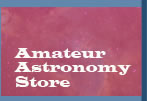

STAR - Small Telescopes and Astronomical Research

Reviewed by Robert Buchheim
This volume presents an expanded version of the material presented at conferences devoted to recent developments in small telescopes and their use for astronomical research and education. “Small” is, of course, a relative term, and the focus here is on apertures smaller than 1 meter ... often much smaller. The papers cover new telescope developments, the application of remote (internet) observatories, research projects based on small telescopes, and some wonderful “success stories” of astronomical research as an educational tool. Throughout, the theme is “first-hand experience”, which brings a nice personal touch to all of the papers. There is quite a bit of very good design and research information here, but it is not a stuffy academic tome.
What should you hope for in a book that is derived from a conference? Clear writing, good coverage of the topics, current thinking of people knowledgeable in their fields, and hopefully a sense of the camaraderie and unique attributes of the conference (and the conferees!) I am pleased to report that it is all here.
Telescopes: Dear me, how rapidly telescope innovation continues! Russ Genet reminiscences about his 1983 robotic photometer telescope, controlled by what was then a new-fangled Radio Shack TRS-80 computer. Alex Filippenko’s description of his first robotic CCD telescope system – which entailed a couple of years of path-breaking work, several hundred thousand dollars, and plenty of troubleshooting to reach effective first light – is an interesting piece of recent history. From that milestone in the mid-90’s, the industry has made a remarkably rapid leap to today’s commercial equipment.
At any point in time, there is the “standard, general purpose” telescope, and there are also custom-designed special purpose telescopes that meet a specific need, defined by the characteristics of the intended project. The amazing thing (to me) is how rapidly yesterday’s “custom/special/expensive” telescope can evolve into today’s “standard general purpose” (and much less expensive) telescope. Today’s SCT+CCD+software system that can be purchased out of the box for a few thousand dollars is a close descendant of Dr. Filippenko’s experimental system, embodying many of its advanced features.
How does this evolution happen? Well, it starts with a healthy dose of intelligent design! The story of the genesis and early history of Celestron, included here, is an entertaining and educational look at the birth of a remarkable technology and an iconic company. The story is not just about optical technology. It is also about the importance of vision, courage, and willingness to learn from your marketplace. Tom Johnson’s first commercial telescope was almost certainly “too advanced”, and it was only after he toned it down that he, his telescope, and his industrial innovation created a whole new market.
The story of the beginning of Celestron is followed by a very good first-hand description of how design and technology evolution is continuing at that enterprise, told by one of the lead engineers.
The evolution is continuing in amateur circles as well. There is a very complete description of the recent invention of very-small-aperture instruments specifically tailored for asteroid occultation timing. These “mighty mini’s” have dramatically increased the productivity and fidelity of the occultation data. And there is a nice first-hand account of the design of a backyard observatory.
Remote Observing: “Real astronomers” today may skip the observing experience altogether. Instead of traveling to cold and oxygen-deprived peaks and staying awake all night conducting observations, they can simply send instructions over the internet to the telescope operator, who (possibly at the base of the mountain in a nice warm control room) enters them into his or her computer console to command the telescope and instruments. The resulting data is then electronically transmitted back to the astronomer for reduction and analysis. While many of us “amateur astronomers” still enjoy the trip to a dark-sky site, spiced by the brisk night air and the howls of coyotes in the distance, we too can take advantage of remote observing. There are several papers describing the merger of robotic telescopes and internet communications. Low-cost, high-productivity and easily-accessible instruments are being used to conduct a variety of research projects.
Projects: Small-telescope research is a special interest of mine so I was delighted to see quite a few discussions of projects – and results – from both amateur/student and professional astronomers. These included CCD photometry of variable stars, double star astrometry, exoplanet transits, and a very sophisticated solar-research program that shows how much can be done with a modest-size telescope in the hands of an expert.
I was one of the participants at the “Galileo’s Legacy” conference (January 2009) that formed the core of this book. Reading the resulting text reminded me how much fun I had – the opportunity to meet some very imaginative people, learn about innovative telescope designs, and see astronomical research projects that are within the range of the backyard scientist and the undergraduate (or even a diligent high school student). Russ Genet, his editors, and the contributing authors have prepared a fulfilling reading experience. It is both nourishing (filled with new ideas and compelling explanations) and entertaining (written for humans, not drones).
------------------
Robert Buchheim is an amateur astronomer, backyard scientist, and author of The Sky Is Your Laboratory.








